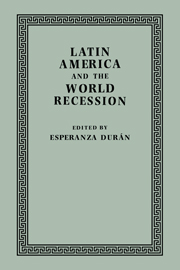Book contents
- Frontmatter
- Contents
- Contributors
- Preface
- 1 The Political Setting: ‘Business as Usual’ or a New Departure?
- Part One The Global Perspective
- Part Two Case Studies
- 5 Brazil's Foreign Debt: The National Debate
- 6 Mexico: Learning to Live with the Crisis
- 7 The Rise and Fall of the Chilean Economic Miracle
- 8 Venezuela: The Oil Boom and the Debt Crisis
- 9 World Recession and Central American Depression: Lessons from the 1930s for the 1980s
- 10 Conclusion
- Index
6 - Mexico: Learning to Live with the Crisis
Published online by Cambridge University Press: 05 February 2012
- Frontmatter
- Contents
- Contributors
- Preface
- 1 The Political Setting: ‘Business as Usual’ or a New Departure?
- Part One The Global Perspective
- Part Two Case Studies
- 5 Brazil's Foreign Debt: The National Debate
- 6 Mexico: Learning to Live with the Crisis
- 7 The Rise and Fall of the Chilean Economic Miracle
- 8 Venezuela: The Oil Boom and the Debt Crisis
- 9 World Recession and Central American Depression: Lessons from the 1930s for the 1980s
- 10 Conclusion
- Index
Summary
The Mexican debt crisis of August–September 1982 was like so many others of the type: surprising at the time, inevitable in retrospect. The main impression which one is left with is how rapidly the crisis developed and how quickly it seems to have subsided. Yet the crisis will linger in the memory within the international financial system and, still more obviously, within Mexico itself. It may also be that its more lasting consequences will be those which at the time were least appreciated. This remains to be seen. One may begin, however, with the crisis itself.
The Mexican economy began to cause concern only in mid-1981. The first sign of trouble was a weakening in the oil market. The head of Pemex, Jorge Diaz Serrano, responded in May by ordering a cut in the oil price; this proved politically inopportune and he was forced to resign. For several more months, Mexico tried to sell its oil too dear and so lost about $1 billion in exports and government revenue. Partly for this reason, the government in mid-1981 called for a reduction in public spending. Things then seemed back under control but a new shock came in November 1981 when the government issued new estimates of the size of its debt and expected deficit for the year (1981) which were both very much higher than expected. Even so, in December the government reduced subsidies on gasoline and allowed prices to rise: and in February 1982 it devalued the peso.
- Type
- Chapter
- Information
- Latin America and the World Recession , pp. 81 - 97Publisher: Cambridge University PressPrint publication year: 1985
- 1
- Cited by



